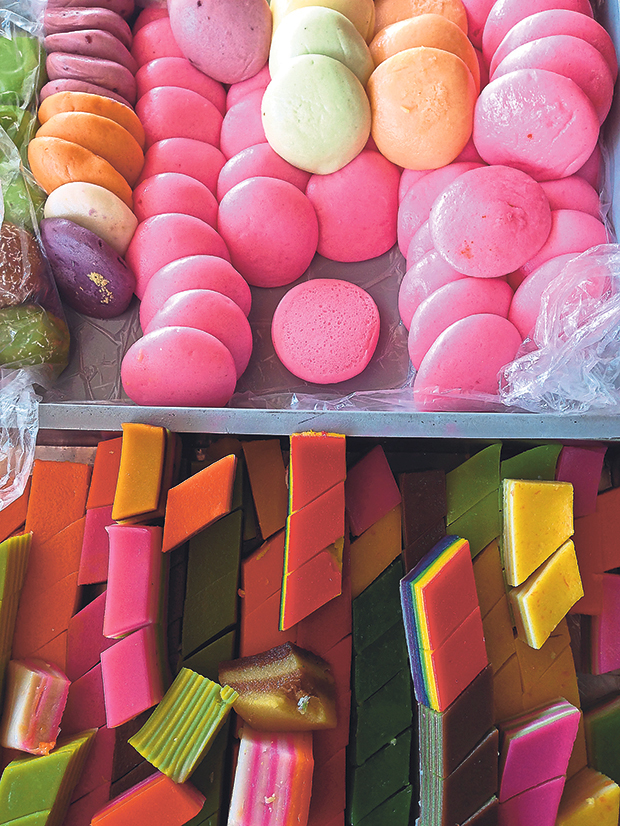KUALA LUMPUR, April 17 — The pending closure of the Imbi market at its original location, announced in March, was met with much dismay and a flurry of city folks flocking to visit its popular stalls one last time. While business is set to resume at the new premise in Pudu, it will never be the same. As any wet market regular will tell you, it’s not only the quality of goods and reasonable prices that keep them going but also the relationship they have built with the sellers over the years, not to mention the authentic atmosphere that you simply can’t recreate. While we rue the closing down of Imbi market, here are eight other traditional wet markets in Kuala Lumpur that have been around for decades but may not be for long if we don’t support the small-time traders who have been keeping it running for generations.
Hot stuff: Pasar Air Panas (Jalan Air Jerneh, Kampung Baru Air Panas, Setapak)
The gilded plaque, now partially hidden behind stalls selling flowers and handicrafts, commemorates the opening of Pasar Air Panas on July 29, 1990 at 2.30pm, officiated by Tun Dr Mahathir. But this roofed market in the Setapak suburb planted its roots — actually, many roots — decades prior when traders would park themselves around the angsana tree that still stands proud right by one of the side entrances.
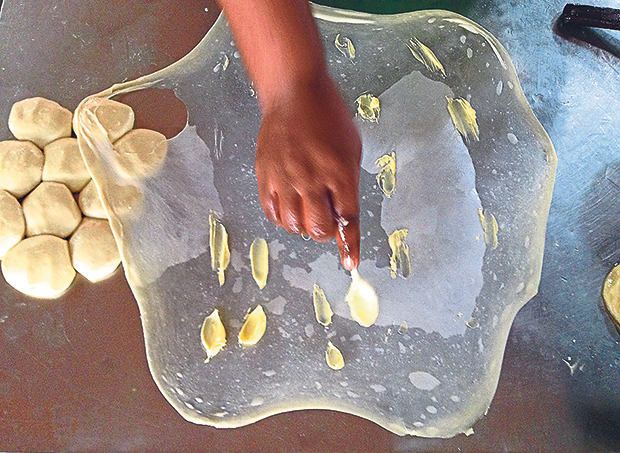
That’s as far as Muhammad Arif remembers, as his late grandfather was one of those early traders who ran a roti canai stall under the tree. The family business has survived for as long, with Arif taking over 16 years ago. The market, he tells me, is his “kampung” and everyone’s a friend.
Arif’s stall is one of many that forms the centrepiece of this well-patronised market, with Chinese proprietors taking up most of the outlets to sell Malaysian breakfast staples including a variety of noodles, chee cheong fun, and economy bihun. Surrounding the hot food kiosks are butchers, fishmongers, fruit and vegetable sellers — basically, everything you’d expect to find at a wet market.
Framing those are small shoplots where you can also buy shoes, fresh santan and grated coconut, prayer items and dried foods.
Comfort level High ceilings, marked by airwells, create an airy ambience while letting natural light through. Even in the current hot spell, it feels cool inside. For a wet market, the floors are comfortably dry and almost spotless as are the public toilets.
Favourite stalls Arif’s regulars usually order the roti Planta or roti bom. Differentiated by their shapes — square and round, respectively — the former has a larger surface area and thus crisps up more on the hot plate. Also, look for the kuih stall with an array of colourful traditional steamed cakes. Try the hei pan, a disc-shaped Hakka treat that’s a cross between a pau and huat kuih in taste and texture. Besides plain buns, there are also variants with coconut fillings and flavoured with pumpkin or tapioca.
Bigger and better: Pasar Chow Kit, Jalan Raja Alang/Jalan Raja Bot
This is one of the city’s biggest wet markets, although on-going construction to uplift its facilities has blocked off part of the space temporarily. With many of the stalls owned by Indonesian immigrants, there is a huge variety of Indonesian cooking ingredients, food products and freshly cooked items. Besides food and fresh produce, there are as many stalls selling clothes, bags, shoes and essential goods. Prices are known to be very reasonable by the city’s standards.


Comfort level The market is separated into several sections, stretching from covered pavilions to street stalls shaded by huge umbrellas, so comfort and heat levels vary accordingly. It’s an interesting browsing spot but if you’re a first-time visitor and thinking of actually doing your marketing here, be prepared for the extra legwork to figure your way through.
Favourite stalls The ulam stalls are excellently stocked with everything you’d need to put together a platter of raw herb salad or rice. Besides fresh herbs, you’ll also find a variety of spices, pastes and cooking sauces to give your curries the necessary kick.
Retro landmark: Pasar Dato’ Keramat, Kampung Dato’ Keramat
One of the city’s oldest Malay markets, this bazaar is still, for many, the go-to place for the best variety of Malay cooking ingredients. Everything, from its mostly wooden architecture to the signboard sporting old-school type, tells of its nearly 40-year-old history. Most of the current stalls are run by second-generation owners and despite efforts to shift them to the nearby Keramat Mall, the proprietors have remained resolute in wanting to stay put. On weekends, parking is almost impossible so it’s best to catch the LRT — the Dato’ Keramat station is a short walk away.

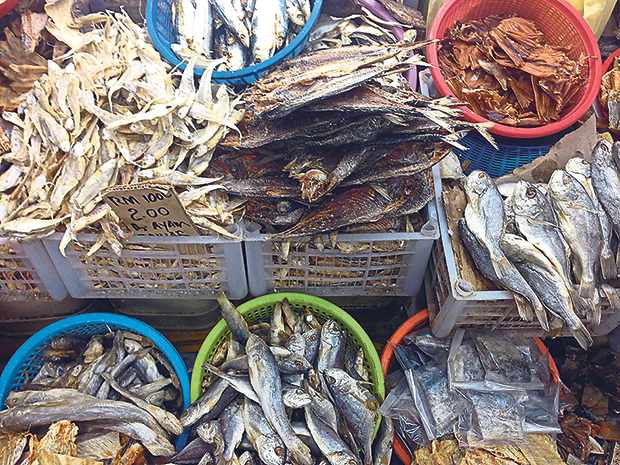
Comfort level Always crowded and with little walking space in between stalls, you can forget sidestepping the puddles and can expect to work up a sweat.
Favourite stalls You can tell basmati from fragrant rice, but until you visit the rice stalls here, you don’t really know your staple grain. Displayed in plastic sacks with the tops rolled down are tens of varieties that go beyond the standard white, brown, long- or short-grain, parboiled or broken rice. Unsure of which to get? Ask and the knowledgeable sellers will tip you on choosing the right one. They will tell you, for example, that the beras jagung (corn rice) is good for diabetics.
Tree-lined avenue: Pasar Desa Setapak (Jalan Rejang, Desa Setapak, Taman Sri Rampai)
Completely outdoors with stalls sitting under or built around existing trees, this is one of the leafiest markets around. Serving mostly regulars from the immediate vicinity, a charming air of familiarity permeates throughout, easily observed from friendly conversations between sellers and shoppers. At the hot food stalls, the elderly gather over mugs of kopi ngalat and tuck into breakfasts using colourful plastic cutlery while discussing current issues and neighbourhood gossip. This market may be small but the variety and quality of goods are more than decent.


Comfort level The trees may not provide much shade, but they create a soothing sight that helps calm even the most harried shopper. Helpfully, the meat stalls are located separately so any strong smells are kept away from the main stretch. However, the road is not closed to vehicles (although the weekend crowds are usually enough to keep sensible drivers away) so watch out.
Favourite stalls The ban chian kuih stall is a weekend special as the owners, an elderly couple, have to babysit their grandchildren on weekdays. Besides the standard crushed peanuts, they make several other variants including chocolate and red beans, and all fillings are homemade.
Pulse of a new village: Pasar Besar Pekan Ampang, Jalan Pasar off Jalan Besar Ampang
Cosy is the word for this Chinese new village market, and not just in the layout but in the prevailing atmosphere as well. There is an air of easy geniality among the sellers as they call out to you to check out their goods and answer your queries about them. Ask to snap some shots and most will answer with an enthusiastic yes followed by a dismissive wave of the hand, as if surprised that you even bother to ask.
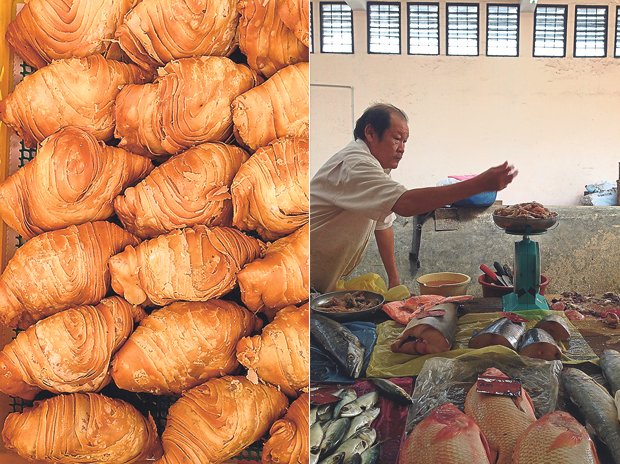
Along the main street, a motley stalls peddle everything from fruits to colourful plastic toys and even holiday packages — the details are handwritten in Chinese on white paper and there are no accompanying photos. Turn off into the small lane next to Seng Kee kopitiam and that is when things start to get really interesting. The first stall you’ll see sells farmed “field chickens” or edible frogs.
The amphibians lie in cages until someone places an order and the proprietor will slaughter them on the spot.
Keep walking along this narrow stretch and you will encounter a stall that sells vintage-style ceramic plates, bowls and cutlery bearing chicken motifs and other designs going for a song: RM10 for three small bowls and RM5 for three soup spoons, for example. Further up, a Chinese dried goods stall (facing the curry puff stall) does roaring business and if you walk into yet another small lane next to it, you will be greeted by a vegetable stall that interestingly, also has an organic section.
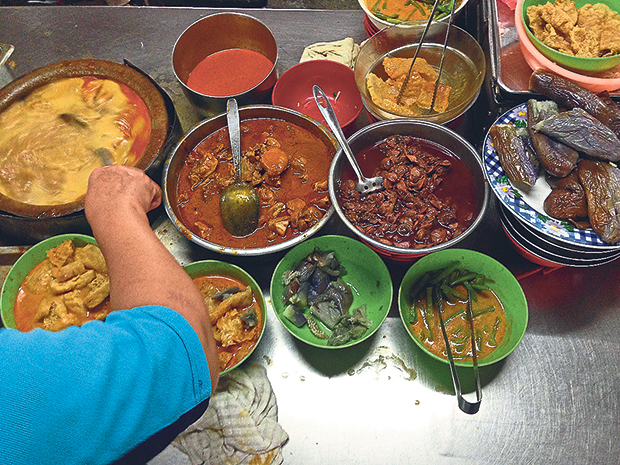
There’s a small selection of organic greens in the refrigerator while the shelves are filled with dried organic goods. It’s certainly a surprising find in an old wet market such as this. The second-generation owner explained that her late mother, who used to run the stall, began eating an organic diet when she fell ill and now the former is continuing to spread awareness on its benefits. “It’s all about education,” she tells me. “Most people here are not familiar with organic food but they are curious, so we do our best to share our knowledge with them.”
Comfort level The market square proper is just like any other old-school wet market, where puddles of water dot the uneven floor and there’s minimal sunlight streaming in through the airwells. But the energy of the place is palpable as traders chat among themselves or with shoppers. It’s quite common to hear them speaking English with their Indian customers.
Favourite stalls The young man behind the plastic trays of baked goods is always friendly and polite, even thanking you for helping to promote his stall if you ask to take a photo. He only operates at this market on weekends, and sells just four items: Egg tarts, kaya puff, curry puff and siew pow. The egg tarts are usually the first to sell out but it’s the curry puff that’s memorable: Flaky layers encase a fat body filled with finely-minced potatoes softened just short of mushy, cloaked in a flavourful spicy sauce and with a wedge of hard-boiled egg thrown in. The seller promises that the skin stays crispy for several hours but chances are, the curry puff won’t last that long.
Shop, see and sup till you drop: Pudu, Jalan Pasar Pudu
Predating the country’s independence by a year and resembling a large warehouse with curved roofs and circular windows, Pasar Pudu lives up to every expectation of being one of the city’s biggest markets — a hive of noise, slimy floors and serious trading. You get the impression that the traders mean business and business only, with little time or patience for banter. If you have questions, keep them short and make it quick.
The “warehouse” section houses mostly the meat stalls with several small kiosks selling dried and fresh South East Asian herbs and spices, some of which are unfamiliar to local cuisine. The Indian chilli paste stall churns out pail after pail of fiery red blends that are sold by weight; the banana stall (near the management office) is worth stopping by if just to find out the many varieties available. They may all look the same at a glance but the menu board lists at least eight types. One of the most popular is the pisang berangan, which the seller told me is also called “pisang Teluk Intan” as they used to grow in abundance in the Perak town — something this Teluk Intan native never knew.
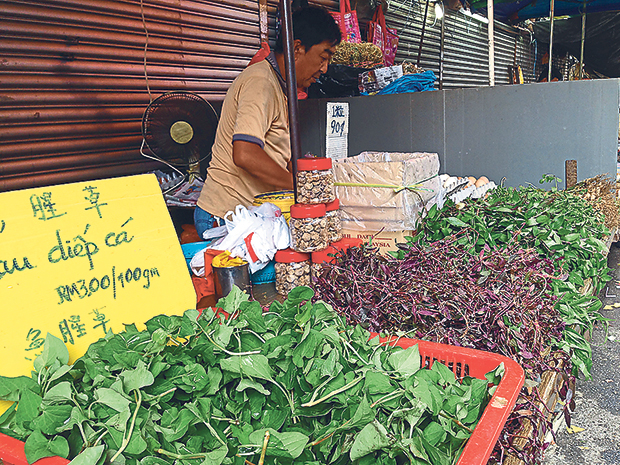
Outside, the al fresco section is more lively as stalls sell a wider variety of goods. Besides the staples, you can find fresh Chinese herbal plants and roots that can be boiled to make cooling teas, or you can buy the teas by the bottles.
On weekends, when you walk through the warren of stalls and towards Jalan Pasar, you will encounter a different bazaar. Lining the pavements are countless peddlers of mobile accessories, small electronic goods and other boys’ toys. Along Jalan Pasar Baharu, facing MH Market Hall, are several small shops where you can buy a variety of tiny fish for your aquariums.
Comfort level The indoor bazaar is best navigated with covered shoes on while the outdoor stalls sit under umbrellas that don’t offer much shade to shoppers. This market is best visited as early in the morning as possible as there’s a lot of ground to cover.
Favourite stalls “Sei sep nin (40 years),” Sulaiman replies in Cantonese when I ask how long he’s been operating his Sulaiman’s Famous Cendol Dan Rojak stall at the fringe of the market (you’ll find him at the start of the covered alleyway next to MH Market Hall). As the majority of his clientele and fellow traders here are Chinese, it’s not surprising that he has picked up a smattering of Cantonese along the way. His prices have increased little through the years; a bowl of cendol starts from RM1.40 for the biasa (no toppings) and up to RM2.20 for the special (with creamed corn, red beans and glutinous rice) for dining in.
A glimmer of the past: Pasar Batu 2 ½ Jalan Ipoh, 322 Jalan Ipoh
It used to be THE place for folks living around Jalan Ipoh and Sentul to get their fresh groceries and indeed, for decades this striking building with tall rectangular windows was a busy hub for the neighbourhood. Pockets of housing areas began disappearing — some due to fires, others given up to modern commercial and residential projects — and took with them the shoppers who used to patronise the market regularly. Today, this market is little more than a shell.
Step in and you’d think you’ve entered an abandoned space, if not for the chicken stall right by the back entrance. The sprightly and well-spoken Madam Chan, who started at the market when she was a young lass of 20 and is now 80 years old, has handed the business over to her son but is still a regular figure at the market. “He doesn’t work for me, I work for him,” she jests.
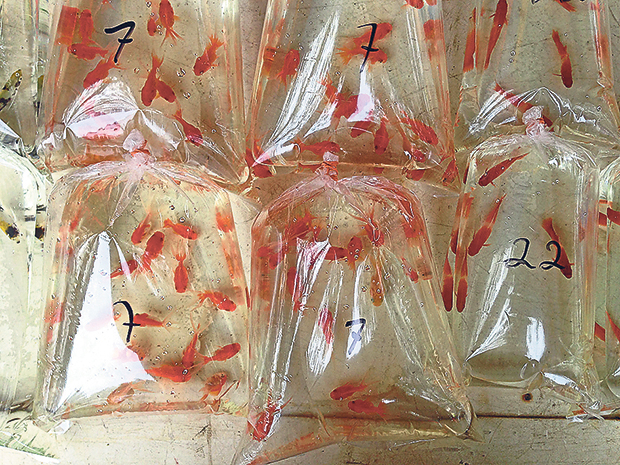
In the Ikan/Fish section, as marked by a handwritten card tacked to the stone column, Mr and Mrs Lee faithfully open their stall every day, closing only during Chinese New Year and Hindu festivals. They only cater to regulars now but once those shoppers are gone, there won’t be any buyers as the new generation hardly finds their way here. According to Mrs Lee, most of the other stalls here closed when the owners passed on or were no longer able to carry out physical work. The stalls have remained vacant for a few years now and efforts to rent them out to new vendors have met with little success.
Today, besides Madam Chan and the Lees, there’s only a handful of traders left here. There are the butchers, an Indian sundry store, and a fruit seller. Behind the Lees’ stall is a coconut milk trader, who only comes late in the evenings and works through the night grating coconut and pressing santan to be delivered to stalls and restaurants first thing in the morning.
It’s a chicken-and-egg situation: Vendors only want to set up shop here if there’s sufficient crowd whereas shoppers will only bother to come if there are enough stalls offering the products and variety they seek. It does indeed look like there’s no way out for this former landmark that is so rich in stories, where the traders’ personal histories are often intimately linked to that of the market.
Mrs Lee, for example, is a third-generation stall owner. Her grandfather used to operate a chap fun stall and later, her father started selling noodles here. Mrs Lee practically grew up here and ended up marrying a second-generation fish monger. In flawless English, she tells me that she wishes there’s more appreciation for heritage buildings such as the one housing this market and that something can be done to bring life back to the market she knows like the back of her hand.
Comfort level The chicken, fish and meat stalls are the only wet areas of the market. At times, you’ll find the traders gathered around the only seating area in the market — in front of the fruit seller and roti canai stall — chatting.
Favourite stalls There’s only one hot food operator left, an Indian roti stall that does a mean masala thosai – thin, crispy crepe filled with well-spiced potatoes.
Fading in plain sight: Petaling Street, Jalan Petaling/off Jalan Tun HS Lee
With nary a crowd and less than half the stalls still in operation, this market has long lost the festive atmosphere it once enjoyed. Like the one in Jalan Sentul, things began slowing down as residential areas in the vicinity gradually made way for commercial development.
Besides the odd regular, most who venture here are either tourists finding their way around Chinatown — one of the entrances is along the main pedestrianised road, next to Loong Kee — or breakfast seekers heading to their favourite Madras Lane cooked food stall. This is the only lively section here, with stalls selling chee cheong fun and curry noodles still doing roaring business.
Comfort level As there are not a lot of activities, even on weekends, it’s constantly cool and dry inside the market.
Favourite stalls Enter through the arch marked “Pusat Penjaja Jalan Tun HS Lee” opposite the Lee Rubber Building, past the Big Mouth Bak Kut Teh Restaurant, and you will come to a tofu stall. The octogenarian owner, who has been selling at the market for 60 years now, sells a variety of the healthy protein, including a homemade white tofu. He makes about five trays each day and sells each block of about 3 x 2 inches (he only cuts them upon order) for only RM1. “It’s the cheapest food around today!” he says, before reminding me that the tofu is best eaten on the same day and that I should submerge the block in water until it’s ready to cook.
As much as she enjoys the comfort of a modern supermarket, Vivian Chong makes it a point to shop at the wet markets every once in a while. Read her other market stories at thisbunnyhops.com
















